Analysis of Communication Strategies for Mr. Fishy Company Report
VerifiedAdded on 2021/02/21
|12
|2010
|19
Report
AI Summary
This report examines communication strategies and challenges faced by Mr. Fishy, a company with centralized decision-making and strict regulations, which has led to poor employee motivation and interpersonal issues. The report reviews existing literature on organizational communication, exploring various forms, principles, and barriers. It analyzes the need for clear, accurate, and timely communication, emphasizing the importance of feedback and employee attentiveness. The analysis reveals that Mr. Fishy plans to implement employee orientation programs to communicate policies, objectives, and foster better interpersonal relationships. The report concludes that effective communication, including two-way feedback and clear messaging, is crucial for achieving organizational goals, and that Mr. Fishy's proposed changes, such as adjusting rules and providing training, will help overcome existing communication barriers, increase employee retention, and improve overall organizational effectiveness.
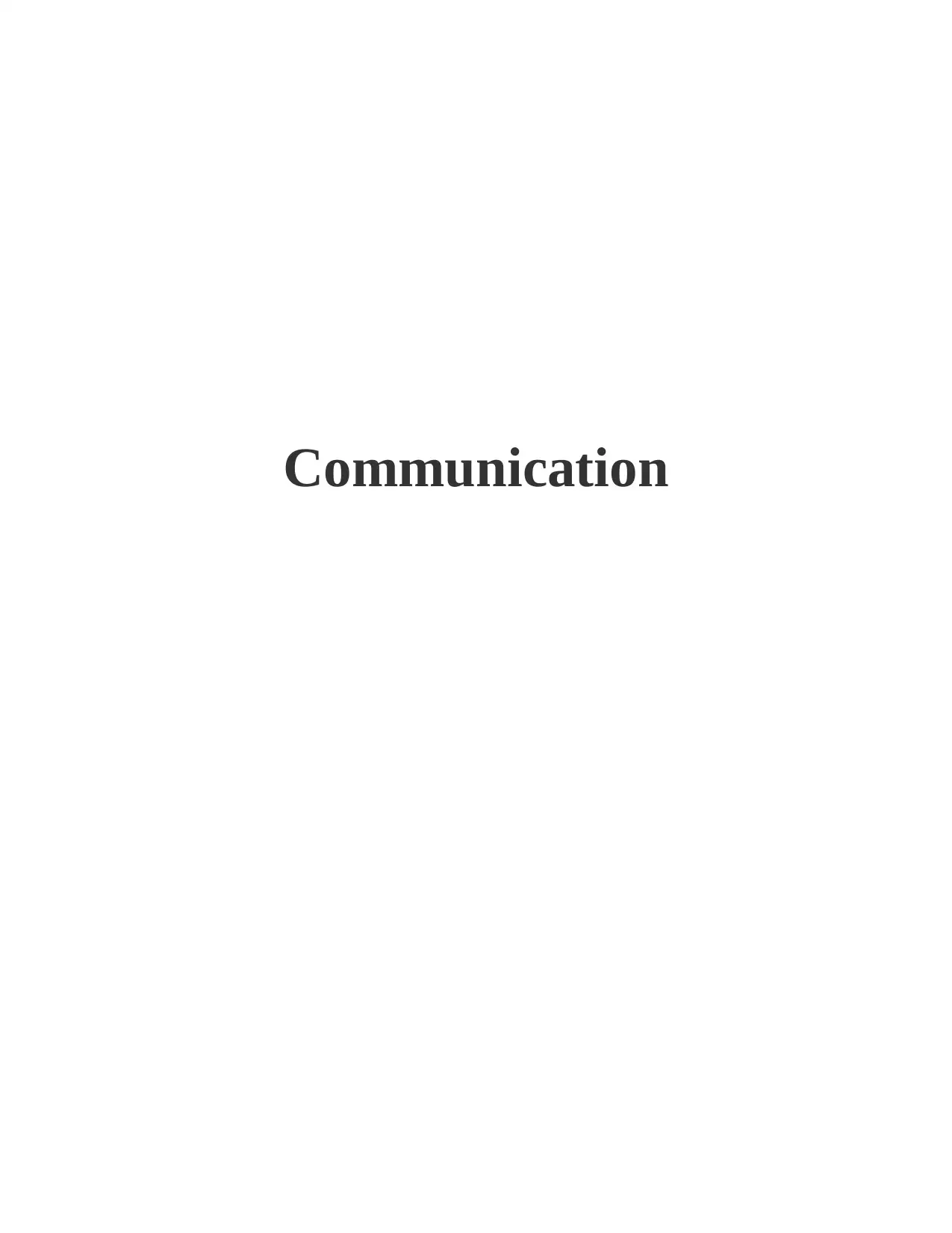
Communication
Paraphrase This Document
Need a fresh take? Get an instant paraphrase of this document with our AI Paraphraser
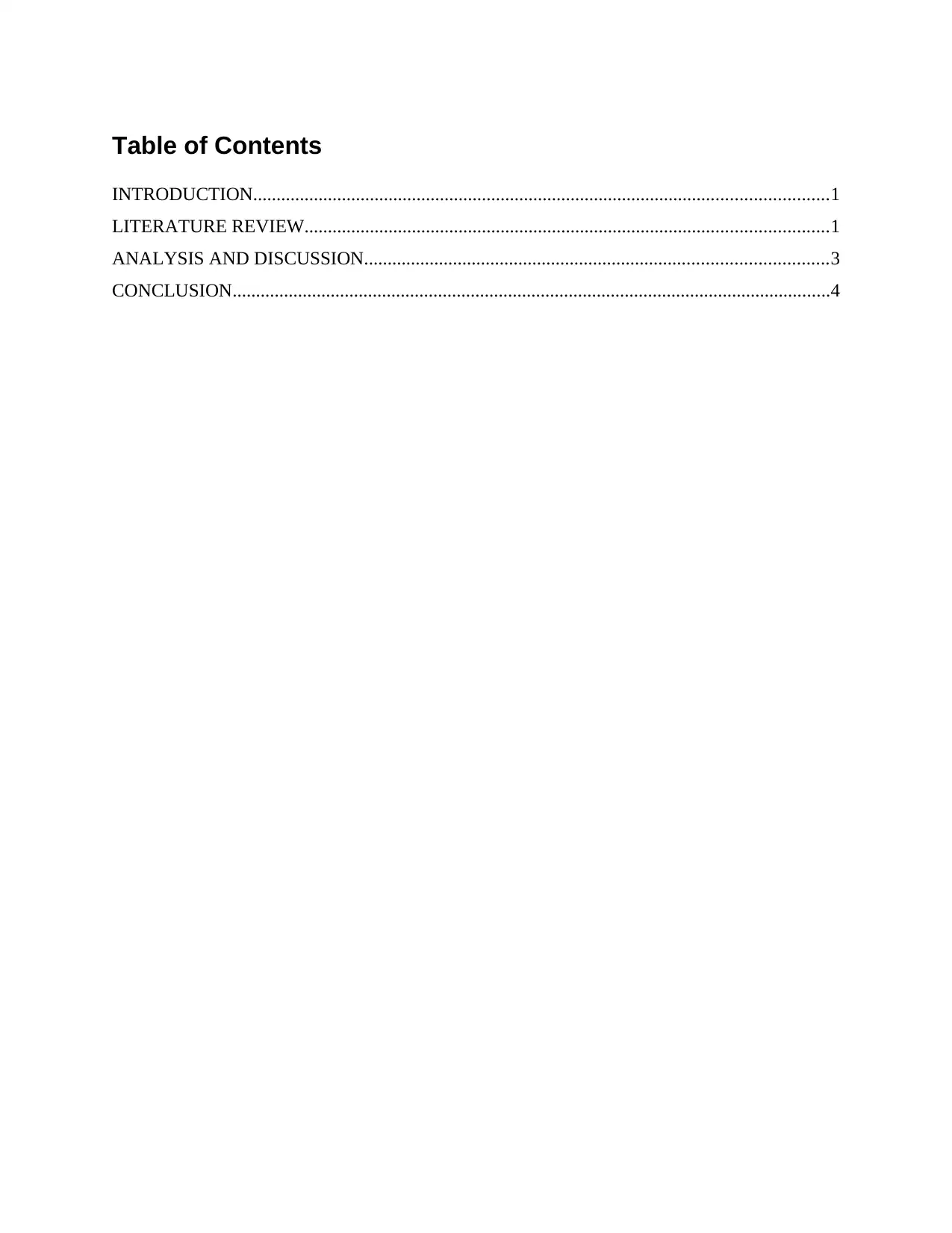
Table of Contents
INTRODUCTION...........................................................................................................................1
LITERATURE REVIEW................................................................................................................1
ANALYSIS AND DISCUSSION...................................................................................................3
CONCLUSION................................................................................................................................4
INTRODUCTION...........................................................................................................................1
LITERATURE REVIEW................................................................................................................1
ANALYSIS AND DISCUSSION...................................................................................................3
CONCLUSION................................................................................................................................4
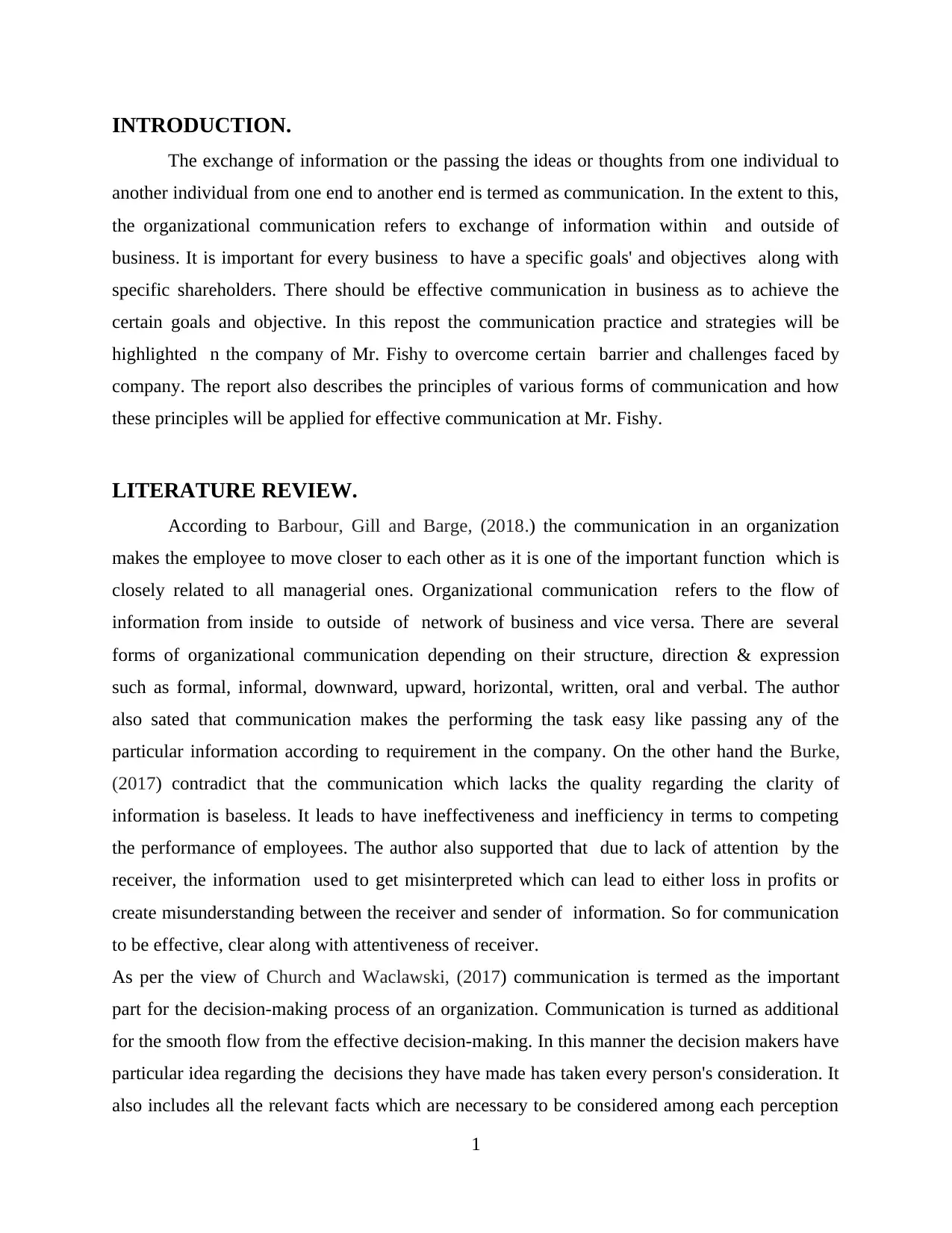
INTRODUCTION.
The exchange of information or the passing the ideas or thoughts from one individual to
another individual from one end to another end is termed as communication. In the extent to this,
the organizational communication refers to exchange of information within and outside of
business. It is important for every business to have a specific goals' and objectives along with
specific shareholders. There should be effective communication in business as to achieve the
certain goals and objective. In this repost the communication practice and strategies will be
highlighted n the company of Mr. Fishy to overcome certain barrier and challenges faced by
company. The report also describes the principles of various forms of communication and how
these principles will be applied for effective communication at Mr. Fishy.
LITERATURE REVIEW.
According to Barbour, Gill and Barge, (2018.) the communication in an organization
makes the employee to move closer to each other as it is one of the important function which is
closely related to all managerial ones. Organizational communication refers to the flow of
information from inside to outside of network of business and vice versa. There are several
forms of organizational communication depending on their structure, direction & expression
such as formal, informal, downward, upward, horizontal, written, oral and verbal. The author
also sated that communication makes the performing the task easy like passing any of the
particular information according to requirement in the company. On the other hand the Burke,
(2017) contradict that the communication which lacks the quality regarding the clarity of
information is baseless. It leads to have ineffectiveness and inefficiency in terms to competing
the performance of employees. The author also supported that due to lack of attention by the
receiver, the information used to get misinterpreted which can lead to either loss in profits or
create misunderstanding between the receiver and sender of information. So for communication
to be effective, clear along with attentiveness of receiver.
As per the view of Church and Waclawski, (2017) communication is termed as the important
part for the decision-making process of an organization. Communication is turned as additional
for the smooth flow from the effective decision-making. In this manner the decision makers have
particular idea regarding the decisions they have made has taken every person's consideration. It
also includes all the relevant facts which are necessary to be considered among each perception
1
The exchange of information or the passing the ideas or thoughts from one individual to
another individual from one end to another end is termed as communication. In the extent to this,
the organizational communication refers to exchange of information within and outside of
business. It is important for every business to have a specific goals' and objectives along with
specific shareholders. There should be effective communication in business as to achieve the
certain goals and objective. In this repost the communication practice and strategies will be
highlighted n the company of Mr. Fishy to overcome certain barrier and challenges faced by
company. The report also describes the principles of various forms of communication and how
these principles will be applied for effective communication at Mr. Fishy.
LITERATURE REVIEW.
According to Barbour, Gill and Barge, (2018.) the communication in an organization
makes the employee to move closer to each other as it is one of the important function which is
closely related to all managerial ones. Organizational communication refers to the flow of
information from inside to outside of network of business and vice versa. There are several
forms of organizational communication depending on their structure, direction & expression
such as formal, informal, downward, upward, horizontal, written, oral and verbal. The author
also sated that communication makes the performing the task easy like passing any of the
particular information according to requirement in the company. On the other hand the Burke,
(2017) contradict that the communication which lacks the quality regarding the clarity of
information is baseless. It leads to have ineffectiveness and inefficiency in terms to competing
the performance of employees. The author also supported that due to lack of attention by the
receiver, the information used to get misinterpreted which can lead to either loss in profits or
create misunderstanding between the receiver and sender of information. So for communication
to be effective, clear along with attentiveness of receiver.
As per the view of Church and Waclawski, (2017) communication is termed as the important
part for the decision-making process of an organization. Communication is turned as additional
for the smooth flow from the effective decision-making. In this manner the decision makers have
particular idea regarding the decisions they have made has taken every person's consideration. It
also includes all the relevant facts which are necessary to be considered among each perception
1
⊘ This is a preview!⊘
Do you want full access?
Subscribe today to unlock all pages.

Trusted by 1+ million students worldwide
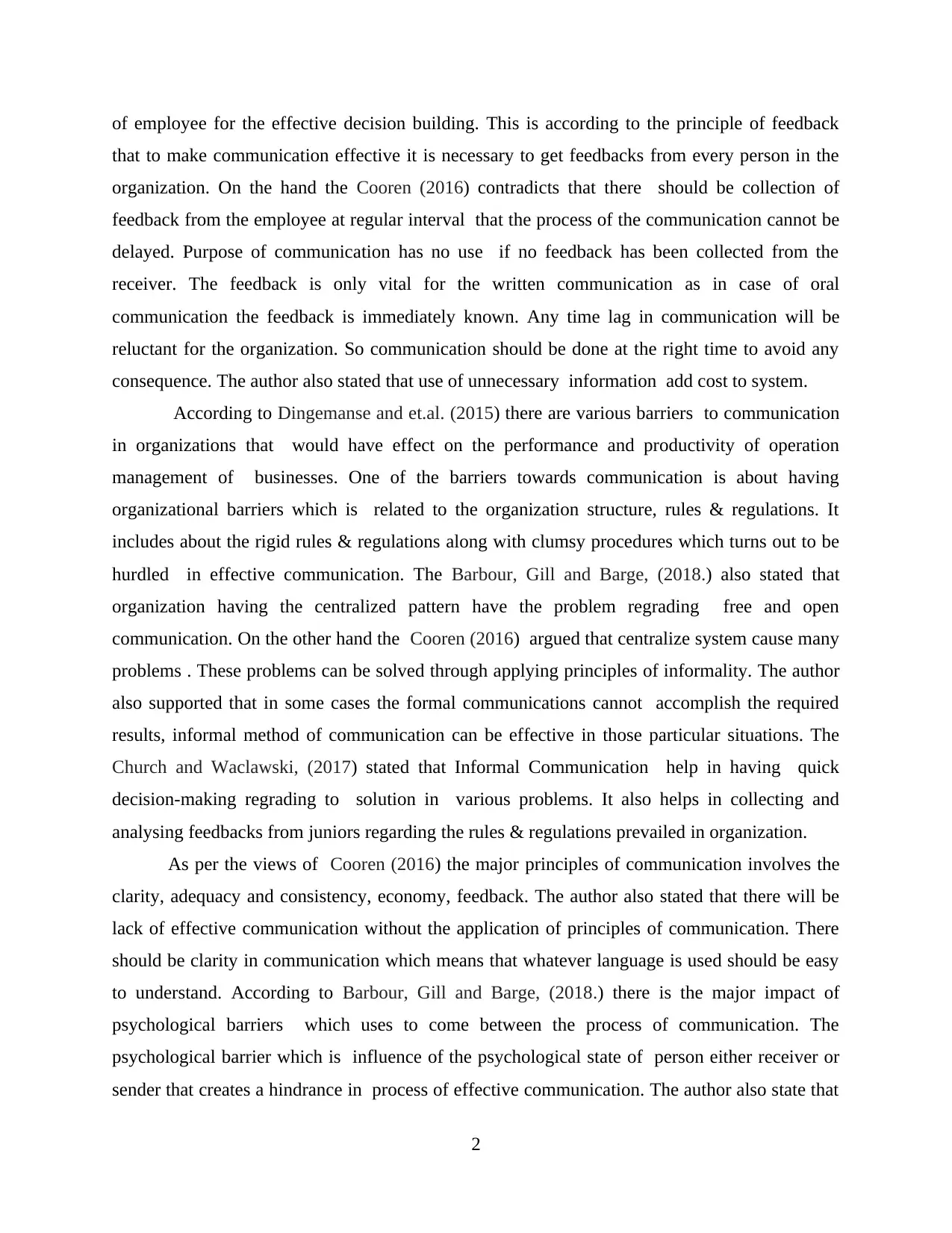
of employee for the effective decision building. This is according to the principle of feedback
that to make communication effective it is necessary to get feedbacks from every person in the
organization. On the hand the Cooren (2016) contradicts that there should be collection of
feedback from the employee at regular interval that the process of the communication cannot be
delayed. Purpose of communication has no use if no feedback has been collected from the
receiver. The feedback is only vital for the written communication as in case of oral
communication the feedback is immediately known. Any time lag in communication will be
reluctant for the organization. So communication should be done at the right time to avoid any
consequence. The author also stated that use of unnecessary information add cost to system.
According to Dingemanse and et.al. (2015) there are various barriers to communication
in organizations that would have effect on the performance and productivity of operation
management of businesses. One of the barriers towards communication is about having
organizational barriers which is related to the organization structure, rules & regulations. It
includes about the rigid rules & regulations along with clumsy procedures which turns out to be
hurdled in effective communication. The Barbour, Gill and Barge, (2018.) also stated that
organization having the centralized pattern have the problem regrading free and open
communication. On the other hand the Cooren (2016) argued that centralize system cause many
problems . These problems can be solved through applying principles of informality. The author
also supported that in some cases the formal communications cannot accomplish the required
results, informal method of communication can be effective in those particular situations. The
Church and Waclawski, (2017) stated that Informal Communication help in having quick
decision-making regrading to solution in various problems. It also helps in collecting and
analysing feedbacks from juniors regarding the rules & regulations prevailed in organization.
As per the views of Cooren (2016) the major principles of communication involves the
clarity, adequacy and consistency, economy, feedback. The author also stated that there will be
lack of effective communication without the application of principles of communication. There
should be clarity in communication which means that whatever language is used should be easy
to understand. According to Barbour, Gill and Barge, (2018.) there is the major impact of
psychological barriers which uses to come between the process of communication. The
psychological barrier which is influence of the psychological state of person either receiver or
sender that creates a hindrance in process of effective communication. The author also state that
2
that to make communication effective it is necessary to get feedbacks from every person in the
organization. On the hand the Cooren (2016) contradicts that there should be collection of
feedback from the employee at regular interval that the process of the communication cannot be
delayed. Purpose of communication has no use if no feedback has been collected from the
receiver. The feedback is only vital for the written communication as in case of oral
communication the feedback is immediately known. Any time lag in communication will be
reluctant for the organization. So communication should be done at the right time to avoid any
consequence. The author also stated that use of unnecessary information add cost to system.
According to Dingemanse and et.al. (2015) there are various barriers to communication
in organizations that would have effect on the performance and productivity of operation
management of businesses. One of the barriers towards communication is about having
organizational barriers which is related to the organization structure, rules & regulations. It
includes about the rigid rules & regulations along with clumsy procedures which turns out to be
hurdled in effective communication. The Barbour, Gill and Barge, (2018.) also stated that
organization having the centralized pattern have the problem regrading free and open
communication. On the other hand the Cooren (2016) argued that centralize system cause many
problems . These problems can be solved through applying principles of informality. The author
also supported that in some cases the formal communications cannot accomplish the required
results, informal method of communication can be effective in those particular situations. The
Church and Waclawski, (2017) stated that Informal Communication help in having quick
decision-making regrading to solution in various problems. It also helps in collecting and
analysing feedbacks from juniors regarding the rules & regulations prevailed in organization.
As per the views of Cooren (2016) the major principles of communication involves the
clarity, adequacy and consistency, economy, feedback. The author also stated that there will be
lack of effective communication without the application of principles of communication. There
should be clarity in communication which means that whatever language is used should be easy
to understand. According to Barbour, Gill and Barge, (2018.) there is the major impact of
psychological barriers which uses to come between the process of communication. The
psychological barrier which is influence of the psychological state of person either receiver or
sender that creates a hindrance in process of effective communication. The author also state that
2
Paraphrase This Document
Need a fresh take? Get an instant paraphrase of this document with our AI Paraphraser

an effective communication is base in on mental condition of the communicators. In case, the
person who is emotionally unwell involves in communication can't communicate properly. The
communication is turned out to be effective id it can proper deliver the message. As per views of
Cooren (2016) if in case boss have trust issues with employees working with him, he will not
be able to share every detail with him, only selective information will be communicated to
employee. This type of barrier occur due to lack of attention, trust issues, difference in attitude &
opinions and closed mindedness. The author also stated that absolute & adequate message must
be communicated in all aspects. Inadequate and incomplete message can caused delay with
implementation of particular action and turned out to be confusion in employees. To take the
particular decision and make plans, there should be accurate & complete information. The
employees should be attentive while having the communication with their subordinates or peers
by keeping aside their ego and treat every employee equally.
ANALYSIS AND DISCUSSION.
It has been analysed that there are several types of communication available in business.
According to point of view from the various author it can be analysed that there are various
principle which are necessary to be implemented to have the effective communication. With
having the effective communication in organization helps in having proper decision-making and
planning of the organization regarding the various aspects. It has been analysed that
communication is necessary for planning any policy, rules or anything as without having
communication nothing is possible. But the important things that has to be kept in mind
regarding the effective communication is that message should be clear, accurate, adequate and
should be on time, then only it will be useful for the businesses. The sender and receiver should
be attentive and promotes motivation for the smooth flow of business operations.
In the organization of Mr. Fishy , there is centralized decision-making along with strict
rule and regulation. This leads to have poor motivation among the employees which leads to
creating the issue among the employee and employer. Mr. Fishy came up with an idea of
employee orientation in which employees will be given orientation regarding policies,
objectives, procedures, authority relations towards the organization. This orientation will also
communicate goals, mission, vision, and they will be a part of their implementation process as
well. There will be improvement in interpersonal relationship among employee and employers
as due to strict policy there were lack of the personal relationship . This will help in increase the
3
person who is emotionally unwell involves in communication can't communicate properly. The
communication is turned out to be effective id it can proper deliver the message. As per views of
Cooren (2016) if in case boss have trust issues with employees working with him, he will not
be able to share every detail with him, only selective information will be communicated to
employee. This type of barrier occur due to lack of attention, trust issues, difference in attitude &
opinions and closed mindedness. The author also stated that absolute & adequate message must
be communicated in all aspects. Inadequate and incomplete message can caused delay with
implementation of particular action and turned out to be confusion in employees. To take the
particular decision and make plans, there should be accurate & complete information. The
employees should be attentive while having the communication with their subordinates or peers
by keeping aside their ego and treat every employee equally.
ANALYSIS AND DISCUSSION.
It has been analysed that there are several types of communication available in business.
According to point of view from the various author it can be analysed that there are various
principle which are necessary to be implemented to have the effective communication. With
having the effective communication in organization helps in having proper decision-making and
planning of the organization regarding the various aspects. It has been analysed that
communication is necessary for planning any policy, rules or anything as without having
communication nothing is possible. But the important things that has to be kept in mind
regarding the effective communication is that message should be clear, accurate, adequate and
should be on time, then only it will be useful for the businesses. The sender and receiver should
be attentive and promotes motivation for the smooth flow of business operations.
In the organization of Mr. Fishy , there is centralized decision-making along with strict
rule and regulation. This leads to have poor motivation among the employees which leads to
creating the issue among the employee and employer. Mr. Fishy came up with an idea of
employee orientation in which employees will be given orientation regarding policies,
objectives, procedures, authority relations towards the organization. This orientation will also
communicate goals, mission, vision, and they will be a part of their implementation process as
well. There will be improvement in interpersonal relationship among employee and employers
as due to strict policy there were lack of the personal relationship . This will help in increase the
3
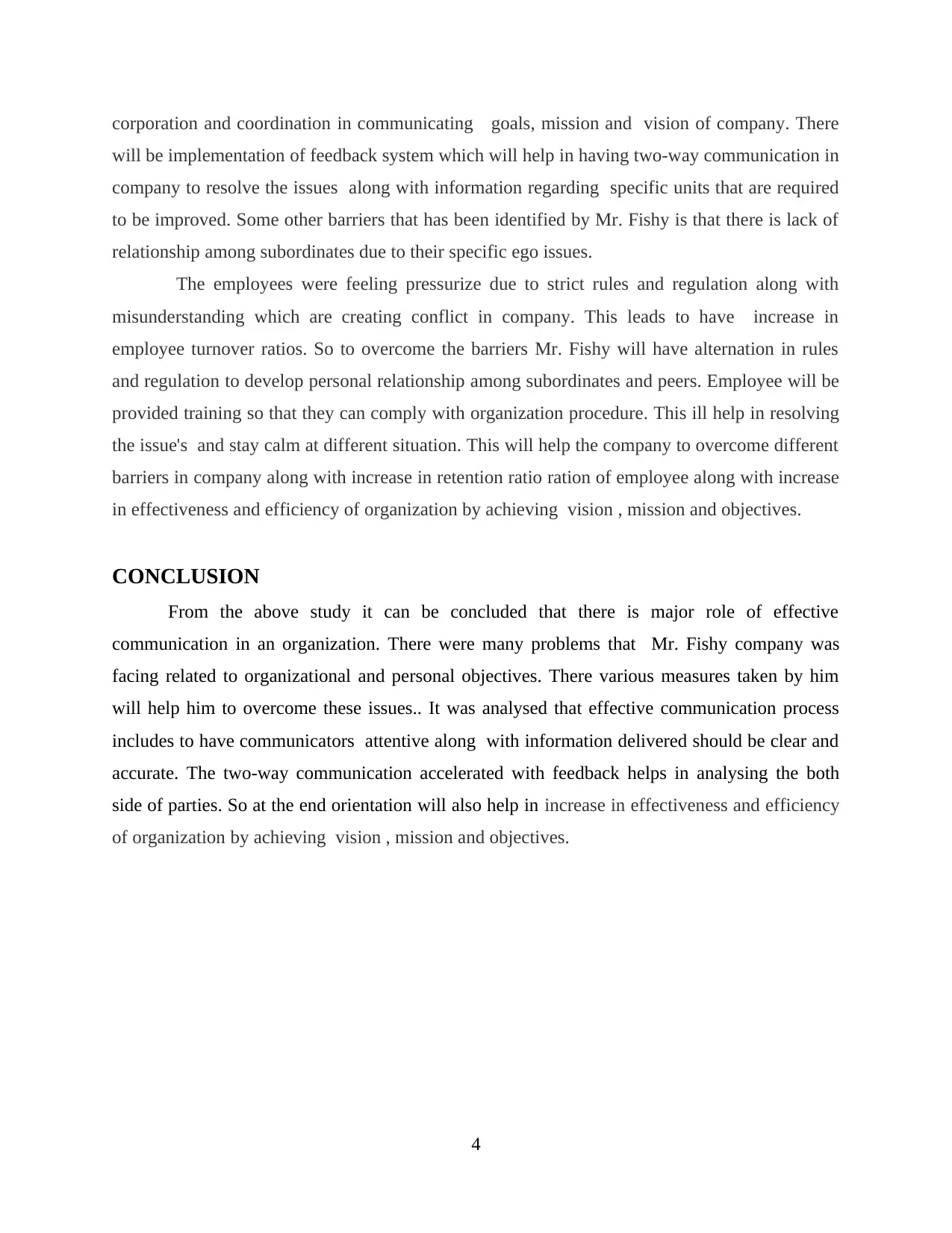
corporation and coordination in communicating goals, mission and vision of company. There
will be implementation of feedback system which will help in having two-way communication in
company to resolve the issues along with information regarding specific units that are required
to be improved. Some other barriers that has been identified by Mr. Fishy is that there is lack of
relationship among subordinates due to their specific ego issues.
The employees were feeling pressurize due to strict rules and regulation along with
misunderstanding which are creating conflict in company. This leads to have increase in
employee turnover ratios. So to overcome the barriers Mr. Fishy will have alternation in rules
and regulation to develop personal relationship among subordinates and peers. Employee will be
provided training so that they can comply with organization procedure. This ill help in resolving
the issue's and stay calm at different situation. This will help the company to overcome different
barriers in company along with increase in retention ratio ration of employee along with increase
in effectiveness and efficiency of organization by achieving vision , mission and objectives.
CONCLUSION
From the above study it can be concluded that there is major role of effective
communication in an organization. There were many problems that Mr. Fishy company was
facing related to organizational and personal objectives. There various measures taken by him
will help him to overcome these issues.. It was analysed that effective communication process
includes to have communicators attentive along with information delivered should be clear and
accurate. The two-way communication accelerated with feedback helps in analysing the both
side of parties. So at the end orientation will also help in increase in effectiveness and efficiency
of organization by achieving vision , mission and objectives.
4
will be implementation of feedback system which will help in having two-way communication in
company to resolve the issues along with information regarding specific units that are required
to be improved. Some other barriers that has been identified by Mr. Fishy is that there is lack of
relationship among subordinates due to their specific ego issues.
The employees were feeling pressurize due to strict rules and regulation along with
misunderstanding which are creating conflict in company. This leads to have increase in
employee turnover ratios. So to overcome the barriers Mr. Fishy will have alternation in rules
and regulation to develop personal relationship among subordinates and peers. Employee will be
provided training so that they can comply with organization procedure. This ill help in resolving
the issue's and stay calm at different situation. This will help the company to overcome different
barriers in company along with increase in retention ratio ration of employee along with increase
in effectiveness and efficiency of organization by achieving vision , mission and objectives.
CONCLUSION
From the above study it can be concluded that there is major role of effective
communication in an organization. There were many problems that Mr. Fishy company was
facing related to organizational and personal objectives. There various measures taken by him
will help him to overcome these issues.. It was analysed that effective communication process
includes to have communicators attentive along with information delivered should be clear and
accurate. The two-way communication accelerated with feedback helps in analysing the both
side of parties. So at the end orientation will also help in increase in effectiveness and efficiency
of organization by achieving vision , mission and objectives.
4
⊘ This is a preview!⊘
Do you want full access?
Subscribe today to unlock all pages.

Trusted by 1+ million students worldwide
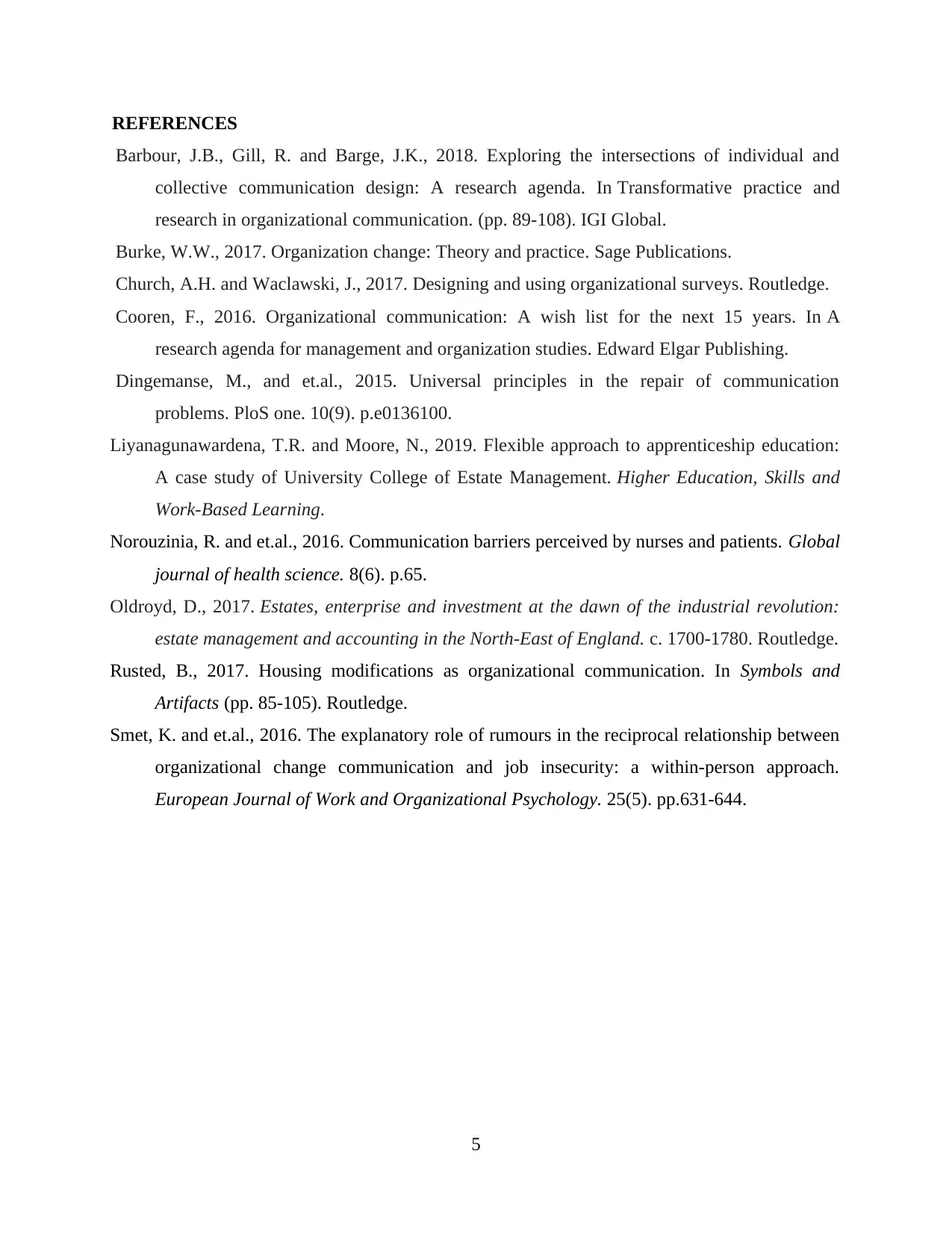
REFERENCES
Barbour, J.B., Gill, R. and Barge, J.K., 2018. Exploring the intersections of individual and
collective communication design: A research agenda. In Transformative practice and
research in organizational communication. (pp. 89-108). IGI Global.
Burke, W.W., 2017. Organization change: Theory and practice. Sage Publications.
Church, A.H. and Waclawski, J., 2017. Designing and using organizational surveys. Routledge.
Cooren, F., 2016. Organizational communication: A wish list for the next 15 years. In A
research agenda for management and organization studies. Edward Elgar Publishing.
Dingemanse, M., and et.al., 2015. Universal principles in the repair of communication
problems. PloS one. 10(9). p.e0136100.
Liyanagunawardena, T.R. and Moore, N., 2019. Flexible approach to apprenticeship education:
A case study of University College of Estate Management. Higher Education, Skills and
Work-Based Learning.
Norouzinia, R. and et.al., 2016. Communication barriers perceived by nurses and patients. Global
journal of health science. 8(6). p.65.
Oldroyd, D., 2017. Estates, enterprise and investment at the dawn of the industrial revolution:
estate management and accounting in the North-East of England. c. 1700-1780. Routledge.
Rusted, B., 2017. Housing modifications as organizational communication. In Symbols and
Artifacts (pp. 85-105). Routledge.
Smet, K. and et.al., 2016. The explanatory role of rumours in the reciprocal relationship between
organizational change communication and job insecurity: a within-person approach.
European Journal of Work and Organizational Psychology. 25(5). pp.631-644.
5
Barbour, J.B., Gill, R. and Barge, J.K., 2018. Exploring the intersections of individual and
collective communication design: A research agenda. In Transformative practice and
research in organizational communication. (pp. 89-108). IGI Global.
Burke, W.W., 2017. Organization change: Theory and practice. Sage Publications.
Church, A.H. and Waclawski, J., 2017. Designing and using organizational surveys. Routledge.
Cooren, F., 2016. Organizational communication: A wish list for the next 15 years. In A
research agenda for management and organization studies. Edward Elgar Publishing.
Dingemanse, M., and et.al., 2015. Universal principles in the repair of communication
problems. PloS one. 10(9). p.e0136100.
Liyanagunawardena, T.R. and Moore, N., 2019. Flexible approach to apprenticeship education:
A case study of University College of Estate Management. Higher Education, Skills and
Work-Based Learning.
Norouzinia, R. and et.al., 2016. Communication barriers perceived by nurses and patients. Global
journal of health science. 8(6). p.65.
Oldroyd, D., 2017. Estates, enterprise and investment at the dawn of the industrial revolution:
estate management and accounting in the North-East of England. c. 1700-1780. Routledge.
Rusted, B., 2017. Housing modifications as organizational communication. In Symbols and
Artifacts (pp. 85-105). Routledge.
Smet, K. and et.al., 2016. The explanatory role of rumours in the reciprocal relationship between
organizational change communication and job insecurity: a within-person approach.
European Journal of Work and Organizational Psychology. 25(5). pp.631-644.
5
Paraphrase This Document
Need a fresh take? Get an instant paraphrase of this document with our AI Paraphraser

6

7
⊘ This is a preview!⊘
Do you want full access?
Subscribe today to unlock all pages.

Trusted by 1+ million students worldwide

8
Paraphrase This Document
Need a fresh take? Get an instant paraphrase of this document with our AI Paraphraser

9

10
⊘ This is a preview!⊘
Do you want full access?
Subscribe today to unlock all pages.

Trusted by 1+ million students worldwide
1 out of 12
Related Documents
Your All-in-One AI-Powered Toolkit for Academic Success.
+13062052269
info@desklib.com
Available 24*7 on WhatsApp / Email
![[object Object]](/_next/static/media/star-bottom.7253800d.svg)
Unlock your academic potential
Copyright © 2020–2025 A2Z Services. All Rights Reserved. Developed and managed by ZUCOL.





